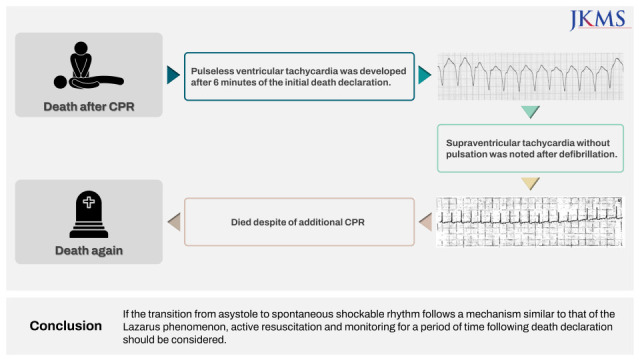1. Letellier N, Coulomb F, Lebec C, Brunet JM. Recovery after discontinued cardiopulmonary resuscitation. Lancet. 1982; 1(8279):1019.
2. Gamboa E, Bronsther O, Halasz N. The Lazarus phenomenon. Clin Transpl. 1986; 125–127. PMID:
3154376.
3. Gordon L, Pasquier M, Brugger H, Paal P. Autoresuscitation (Lazarus phenomenon) after termination of cardiopulmonary resuscitation - a scoping review. Scand J Trauma Resusc Emerg Med. 2020; 28(1):14. PMID:
32102671.
4. Daou O, Winiszewski H, Besch G, Pili-Floury S, Belon F, Guillon B, et al. Initial pH and shockable rhythm are associated with favorable neurological outcome in cardiac arrest patients resuscitated with extracorporeal cardiopulmonary resuscitation. J Thorac Dis. 2020; 12(3):849–857. PMID:
32274152.
5. Escutnaire J, Genin M, Babykina E, Dumont C, Javaudin F, Baert V, et al. Traumatic cardiac arrest is associated with lower survival rate vs. medical cardiac arrest - results from the French national registry. Resuscitation. 2018; 131:48–54. PMID:
30059713.
6. Ekmektzoglou KA, Koudouna E, Bassiakou E, Stroumpoulis K, Clouva-Molyvdas P, Troupis G, et al. An intraoperative case of spontaneous restoration of circulation from asystole: a case of lazarus phenomenon. Case Rep Emerg Med. 2012; 2012:380905. PMID:
23326710.
7. Mahon T, Kalakoti P, Conrad SA, Samra NS, Edens MA. Lazarus phenomenon in trauma. Trauma Case Rep. 2020; 25:100280. PMID:
31921960.
8. Bäcker H, Kyburz A, Bosshard A, Babst R, Beeres FJ. Dead or dying? Pulseless electrical activity during trauma resuscitation. Br J Anaesth. 2017; 118(5):809. PMID:
28510749.
9. Maeda H, Fujita MQ, Zhu BL, Yukioka H, Shindo M, Quan L, et al. Death following spontaneous recovery from cardiopulmonary arrest in a hospital mortuary: ‘Lazarus phenomenon’ in a case of alleged medical negligence. Forensic Sci Int. 2002; 127(1-2):82–87. PMID:
12098530.
10. Kuisma M, Salo A, Puolakka J, Nurmi J, Kirves H, Väyrynen T, et al. Delayed return of spontaneous circulation (the Lazarus phenomenon) after cessation of out-of-hospital cardiopulmonary resuscitation. Resuscitation. 2017; 118:107–111. PMID:
28750883.
11. Sahni V. The Lazarus phenomenon. JRSM Open. 2016; 7(8):2054270416653523. PMID:
27540490.
12. Olasveengen TM, Samdal M, Steen PA, Wik L, Sunde K. Progressing from initial non-shockable rhythms to a shockable rhythm is associated with improved outcome after out-of-hospital cardiac arrest. Resuscitation. 2009; 80(1):24–29. PMID:
19081664.
13. Zhang W, Luo S, Yang D, Zhang Y, Liao J, Gu L, et al. Conversion from nonshockable to shockable rhythms and out-of-hospital cardiac arrest outcomes by initial heart rhythm and rhythm conversion time. Cardiol Res Pract. 2020; 2020:3786408. PMID:
32300483.
14. Wind J, van Mook WN, Dhanani S, van Heurn EW. Determination of death after circulatory arrest by intensive care physicians: a survey of current practice in the Netherlands. J Crit Care. 2016; 31(1):2–6. PMID:
26431638.
15. Dhanani S, Ward R, Hornby L, Barrowman NJ, Hornby K, Shemie SD, et al. Survey of determination of death after cardiac arrest by intensive care physicians. Crit Care Med. 2012; 40(5):1449–1455. PMID:
22430244.


